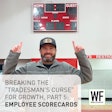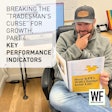
Continuing our series with a roadmap for how to “break the tradesman’s curse” to grow your business (see the article from the October/November 2023 issue here, Part 1: Standard Operating Procedures, Part 2: Project Analysis, Part 3: Setting Quality Standards, Part 4: Key Performance Indicators, Part 5: Employee Scorecards, and Part 6: Performance Pay) …
In the world of wood flooring, the beauty of a perfectly finished oak plank is unmatched. However, equally important but less glamorous is budgeting and cash flow management. Just like a solid subfloor supports your prized hardwood, a solid financial plan is crucial for sustaining your business as it grows. Let’s explore budgeting and cash flow projection with a fresh outlook. Understanding lead and lag measures can be as satisfying as that final coat of polyurethane.
Lead Measures vs. Lag Measures: The Dynamic Duo
Before diving into budgeting, let's talk about lead and lag measures. Think of them as the saw and tape measure in your toolkit—each crucial for financial success.
Lead Measures: These proactive steps influence future outcomes. For wood flooring businesses, lead measures focus on:- Tracking Accounts Receivable: Ensuring timely client payments.
- Monitoring Cash Flow: Regularly reviewing statements to anticipate shortages.
- Budgeting Regularly: Updating your budget based on new financial data.
Lag Measures: These results reflect past efforts, like:
- Revenue: Money from completed projects.
- Customer Satisfaction: Client feedback.
- Profit Margins: Business financial health.
Lag measures show how your proactive efforts are paying off.
From Theory to Practice: My Journey
I’ve read many business books and listened to countless podcasts. Titles like "The E-Myth" and "Profit First for Contractors" buzzed around my brain. Translating this knowledge into actionable steps for my small wood flooring business was challenging.
Joining a mastermind group through Floor Academy was eye-opening. Watching larger companies refine their systems was enlightening. The big takeaway? Create a solid business management system early on. We set quarterly goals and refined our processes, meeting bi-weekly for accountability and feedback.
Hiring a CFO Coach: A Game-Changer
Hiring a CFO coach who handles our books and taxes was liberating. It meant letting go of pride and accepting external advice. Our coach gave us monthly homework and feedback. We shifted from being reactive to proactive.
Together, we developed a cash flow projection spreadsheet. This tool helps us budget for payroll and overhead, incorporating deposit and final payment information based on scheduled completion dates. With a running balance, we can plan the entire year, anticipating strong and weak months. This proactive approach drastically reduced chaos.
Personal Story: A Humbling Lesson in Cash Flow Management
A few years ago, we were barely making payroll because our growth was outpacing our ability to track when payments would cover expenses, especially when a project faced unexpected delays. Picture us, nervously refreshing the bank account, hoping that check would clear before the bills did.
In a desperate move to avoid financial disaster, we made a simple spreadsheet to see when we were about to go broke. Miraculously, it worked! We figured out how to avoid cash flow shortfalls, and let me tell you, it felt like winning the lottery. Things can be lush or lean at times, but having a solid plan is far less stressful and keeps your business operating from a place of strength.
Budgeting: Your Business’s Blueprint
Your budget is your business’s blueprint. It’s not just numbers; it’s a strategic plan for your money.
Forecast Revenue: Estimate income using historical data and market trends. Use your project schedule to input deposits and final payments. Realism pays the bills.
Estimate Expenses: List all costs, including irregular expenses like new equipment. We separate our budget into 3 categories: monthly reoccurring, sinking funds and sporadic expenses.
Plan for Profit: Set aside revenue as profit deliberately to ensure growth.
Cash Flow Projection: Timing Is Everything
Cash flow projection is your financial GPS, helping you navigate income and expenses smoothly.
Monitor Inflows and Outflows: Track money coming in and going out.
Schedule Major Expenses: Plan big purchases when cash flow is strong.
Stay Ahead: Use projections to foresee and mitigate potential problems.
Tools of the Trade: Software and Spreadsheets
Today, tools like QuickBooks, Xero, or a business CRM offer comprehensive solutions. For hands-on approaches, Excel or Google Sheets can be powerful allies and easily customizable to your business.
Solving the Frustration of Growth
Growing a wood flooring business without a solid budget and cash flow system can feel like installing a floor without measuring—frustrating and error-prone. Without a clear financial roadmap, you’re likely to face cash shortfalls and missed opportunities. By adopting a structured system, you reduce stress and open avenues for strategic growth.
The Payoff: Strategic Growth and Peace of Mind
Mastering budgeting and cash flow management provides financial stability and peace of mind. You’ll know when to buy inventory, invest in new equipment, or reward yourself. Reduced chaos means focusing on growth and delighting customers.
So, fellow wood flooring enthusiasts, redefine success by embracing budgeting and cash flow projections. Your business—and your sanity—will thank you.
While the wood you lay might be timeless, your finances need constant attention. Stay proactive, be strategic, and watch your business shine as brightly as your finest finish, all while enjoying the calm that comes from a chaos-free financial system.
If you need help creating a budget and cash flow management system, feel free to reach out. We have many great tools we’ve created for our company that we would love to share. Reach me via email, find us on our website sanangelocraftsman.com or follow us on social media on Facebook and Instagram.
This is our final blog post to wrap up this great journey about business management and redefining what success looks like in this industry! Be sure to read the WFB Magazine article “Building Systems to Break the ‘Tradesman’s Curse’ for Growth in Your Wood Flooring Business” and all our blog posts in this series:
Breaking the “Tradesman’s Curse” for Growth, Part 1: Creating Your Standard Operating Procedures
Breaking the 'Tradesman’s Curse' for Growth, Part 2: Project Analysis
Breaking the 'Tradesman’s Curse' for Growth, Part 3: Setting Quality Standards
Breaking the 'Tradesman’s Curse' for Growth, Part 4: Key Performance Indicators
Breaking the 'Tradesman’s Curse' for Growth, Part 5: Employee Scorecards
Breaking the 'Tradesman’s Curse' for Growth, Part 6: Performance Pay
Stay tuned as we answer frequent questions that we get about implementation and strategy when building a solid foundation for your business!































